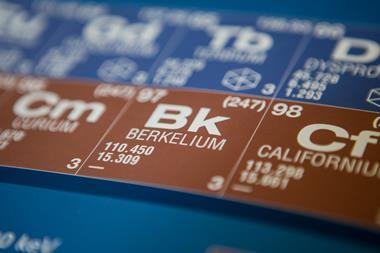Pharmaceutically active ionic liquids have been immobilised onto solid supports to enable liquid drugs to be administered in solid form. Scientists from the US and Europe hope that their work will make the pharmaceutical industry consider ionic liquids as a viable alternative to solid drugs.
Pharmaceutically active ionic liquids are more soluble and stable than solid drugs and they are better at getting across cell membranes. But they are difficult to prepare and are not easy to handle. Robin Rogers from the University of Alabama in the US and colleagues immobilised the liquids onto mesoporous silica to improve preparation and handling.
The team combined known active pharmaceutical ingredients (APIs) into new dual functioning liquid salts in two ways. 'In the first, we combined an acidic API with a basic API simply by grinding or mixing them together,' explains Rogers. 'This produces a salt in which the proton has transferred from the acid to the base.' In the second, they started with a cationic API and an anionic API and exchanged the inert counterions to produce a new salt of API1+ and API2-.
The team immobilised the liquid salts onto silica, resulting in a thin layer of ionic liquid on the silica's interior pores. They then demonstrated that the release of the API could be controlled as it travels to its target in the body by testing it in different body fluids - phosphate buffer saline, simulated gastric fluid and simulated intestinal fluid. They found that in the gastric and intestinal fluids, the release of the API was incomplete. In the phosphate buffer saline, the drug was completely released.
'This important development demonstrates how pharmaceutically active ionic liquids can be used in "dry", free-flowing solid formulations with tuneable release characteristics,' says Douglas MacFarlane, an expert in ionic liquids and their applications from Monash University, Australia. 'The ability to combine two actives in a single delivery vehicle creates the fascinating possibility of realising the synergistic effects of the two actives.' He adds that pharmaceutically active ionic liquids are one of the most exciting directions to emerge in drug discovery in recent years.
'Overcoming the reliance on the crystalline or amorphous solid state and taking advantages of a liquid salt form where both ions can be biologically active will require the pharmaceutical industry to think differently about what constitutes a viable product,' says Rogers. 'Having a way to use the liquid salt but handle it in a solid form may help overcome this reticence and allow the full potential of the API-IL [ionic liquid] approach to be realised.'
Elinor Richards
References
- K Bica et al, Chem. Commun., 2012, DOI: 10.1039/c2cc30959a






No comments yet